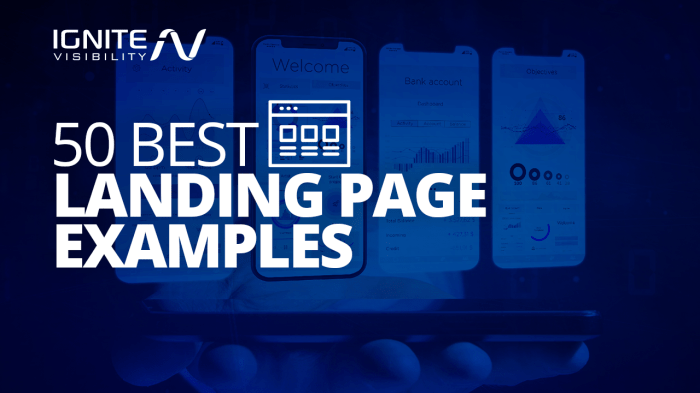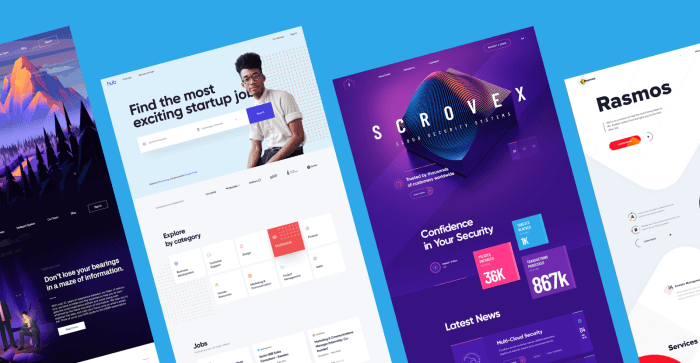Kicking off with Effective Landing Pages, this opening paragraph is designed to captivate and engage the readers, setting the tone american high school hip style that unfolds with each word.
Landing pages are the unsung heroes of online marketing, the secret sauce that turns visitors into customers in a digital blink. In a world where attention spans are shorter than a TikTok video, creating landing pages that pop is the key to standing out in the crowded online space. Let’s dive into what makes them tick and how you can craft your own digital masterpieces that drive those sweet, sweet conversions.
Importance of Effective Landing Pages
Landing pages play a crucial role in online marketing campaigns as they are the first point of contact between a potential customer and a business. A well-designed landing page has the power to capture a visitor’s attention, convey the key message, and ultimately drive them to take a desired action.
When it comes to conversion rates, a well-crafted landing page can significantly impact the outcome of a marketing campaign. By focusing on a specific offer or product and eliminating distractions, a landing page can increase the likelihood of a visitor completing a desired action, such as making a purchase or signing up for a newsletter.
Examples of Successful Landing Pages and Key Features
Successful landing pages often share common key features that contribute to their effectiveness. Here are some examples:
- Clear and concise headline that grabs attention
- Compelling copy that highlights the benefits of the offer
- Visually appealing design with relevant images or videos
- Strong call-to-action that prompts the visitor to take the next step
- Minimal distractions and a focused layout to guide the visitor towards the desired action
Elements of a High-Converting Landing Page: Effective Landing Pages

When it comes to creating a landing page that converts visitors into customers, there are several key elements that play a crucial role in its success. From compelling headlines to clear CTAs, every component of a landing page must work together seamlessly to drive conversions and achieve the desired outcome.
Headlines
The headline is the first thing visitors see when they land on your page, so it needs to grab their attention immediately. A compelling headline should be clear, concise, and relevant to the offer or product being promoted. It should also convey the value proposition and entice visitors to keep reading.
CTAs
A strong Call-to-Action (CTA) is essential for guiding visitors towards the desired action, whether it’s making a purchase, signing up for a newsletter, or downloading a resource. The CTA should be prominently displayed on the page, use action-oriented language, and stand out visually to attract attention.
Images
Images play a crucial role in capturing the visitor’s interest and conveying information quickly and effectively. High-quality, relevant images can help to reinforce the message of the landing page, showcase the product or service being offered, and create a visually appealing experience for the visitor.
Forms, Effective Landing Pages
Forms are used to collect information from visitors and convert them into leads or customers. It’s important to keep forms simple, asking for only essential information, and make them easy to fill out. Additionally, providing clear instructions and using visual cues can help improve the form completion rate.
Clear and Concise Copywriting
Clear and concise copywriting is crucial for ensuring that visitors understand the offer, benefits, and value proposition of the product or service being promoted. Avoiding jargon, using simple language, and focusing on the benefits to the customer can help to increase engagement and conversions on the landing page.
Optimizing Loading Speed
Optimizing the loading speed of a landing page is essential for providing a smooth and seamless user experience. Slow loading times can lead to high bounce rates and lower conversion rates. To optimize loading speed, consider compressing images, minifying code, and reducing server response times to ensure fast page load times for visitors.
Design Best Practices for Landing Pages

When it comes to creating a killer landing page, the design plays a crucial role in capturing the attention of visitors and encouraging them to take action. Here are some tips to help you design a visually appealing layout that converts:
Importance of Responsive Design for Mobile Users
In today’s mobile-driven world, it’s essential to ensure that your landing page is optimized for all devices, especially smartphones and tablets. Responsive design allows your page to adapt to different screen sizes, providing a seamless user experience no matter how visitors access your site.
- Make sure your layout is mobile-friendly and easy to navigate on smaller screens.
- Optimize images and text for quick loading times on mobile devices.
- Use large, tappable buttons and clear calls-to-action to make it easy for users to take the next step.
Examples of Color Schemes and Typography Choices
Choosing the right color scheme and typography can significantly impact the overall look and feel of your landing page. Here are some examples of effective choices:
- Color scheme: Consider using contrasting colors to make important elements stand out, such as buttons and headlines. Use colors that evoke the right emotions and align with your brand identity.
- Typography: Select fonts that are easy to read and reflect the tone of your message. Use a combination of fonts for headings and body text to create hierarchy and visual interest.
A/B Testing and Optimization Strategies
A/B testing is a crucial tool in improving the performance of landing pages. By testing different variations of elements on a page, marketers can gather valuable data on what resonates best with their audience and drives conversions.
Analyzing Data for Optimization
When analyzing data from A/B tests, it’s important to look at key metrics such as click-through rates, bounce rates, and conversion rates. By comparing the performance of different variations, marketers can identify patterns and insights that can guide optimization efforts.
- Utilize tools like Google Analytics to track and measure the impact of each variation on user behavior.
- Pay attention to qualitative feedback from users, such as comments or surveys, to understand their preferences and pain points.
- Look for statistically significant results to ensure that any changes made are based on reliable data.
Tips for Iterating and Continuous Improvement
Once data has been analyzed, it’s important to use insights to iterate and continuously improve landing pages for better performance.
- Implement changes based on data-driven decisions rather than personal preferences or assumptions.
- Test one element at a time to isolate the impact of each change and avoid confusion in results.
- Regularly monitor and track performance metrics to assess the impact of optimizations and make further adjustments as needed.